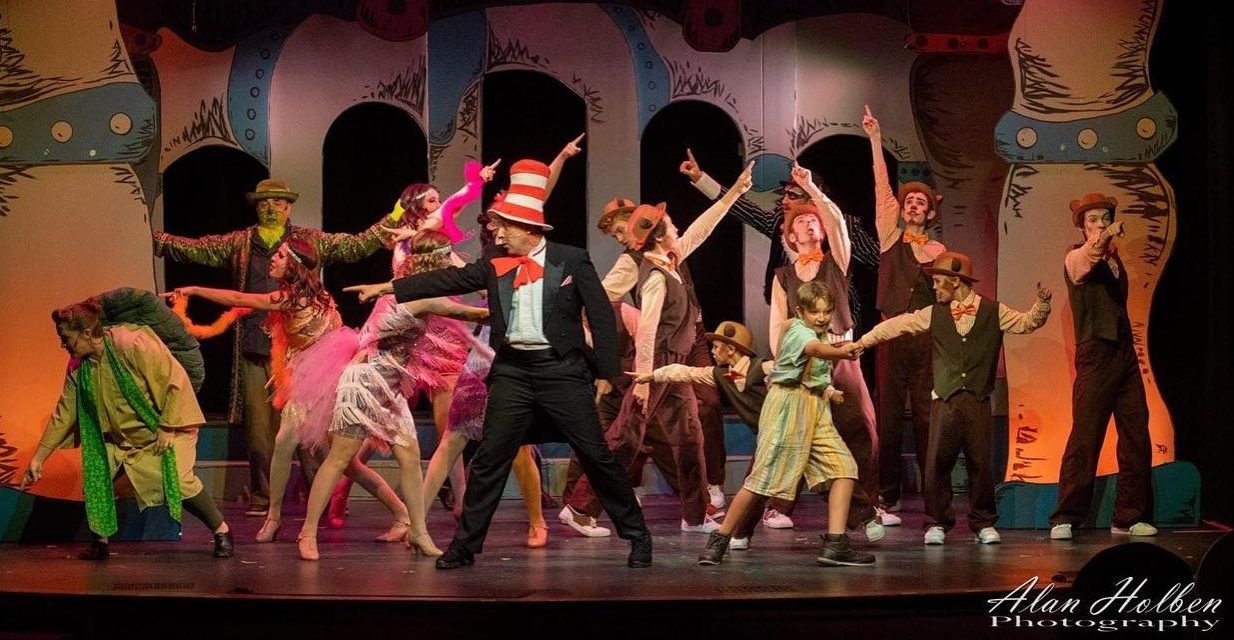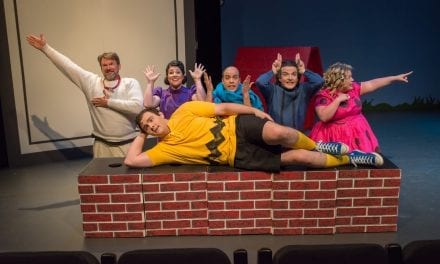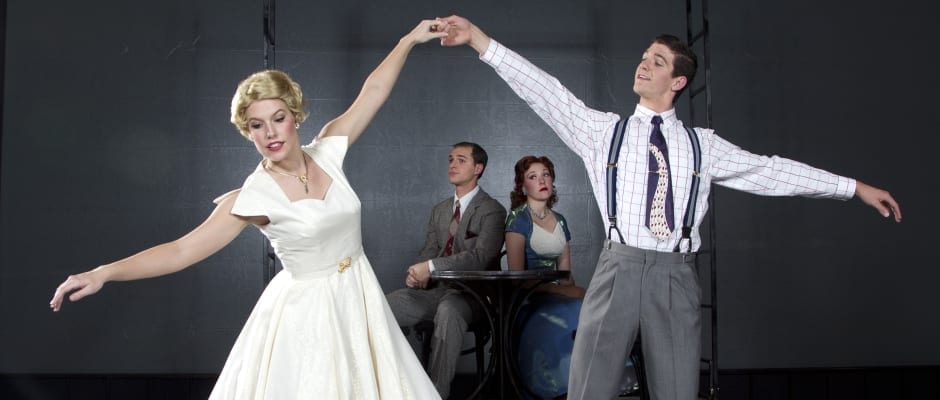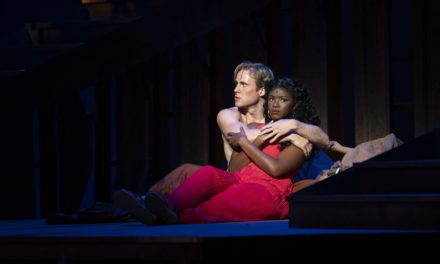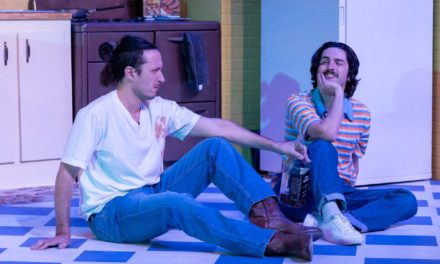ST. GEORGE – Seussical the Musical is a fast-paced race through the world of Dr. Seuss alongside some of his most beloved characters. Fitting for the show, The Stage Door’s production of Seussical is a jazzy tribute to the timeless children’s books.
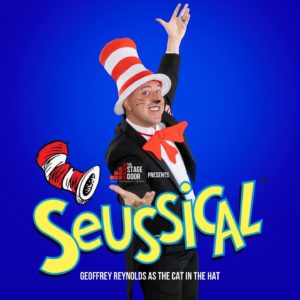
Show closes July 16, 2022.
Seussical (with music by Stephen Flaherty, lyrics by Lynn Ahrens, and a script by Flaherty and Ahrens) follows Horton the Elephant as he discovers a tiny world on a speck of dust and fights to protect it as well as an egg that is left in his care by the Amayzing Mayzie LaBird. Meanwhile, JoJo (a citizen of the tiny world and son of the Mayor), is encouraged to think by the wily Cat in the Hat and is sent to military school for thinking too many “thinks.” The stories are woven together by the Cat in the Hat as he travels seamlessly through the worlds, donning different identities to both narrate and move the story along. Horton and JoJo must use courage, hope, and love to find the way back to their communities.
Director Brianna Rosia does everything big. The cast is gigantic, with a whopping 54 actors and actresses named in the program. The sets take up half the stage. The props are larger than life, and the music is nearly deafening. Each of these aspects alone are enjoyable and awe-inspiring, but combined make for a spectacle that sometimes borders on messy.
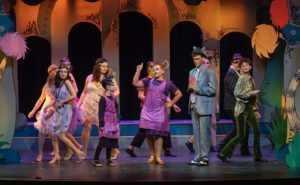 There is a lot to say about the acting in this production, mostly because there are a lot of actors. There were no weak links, Rosia’s bold and inclusive casting works well in favor of the show. The Whoville Citizens in particular are charming beyond measure, with cast members ranging from a real-life baby to the old and gruff General and Grinch, each one brimming with zeal and joy in the performance.
There is a lot to say about the acting in this production, mostly because there are a lot of actors. There were no weak links, Rosia’s bold and inclusive casting works well in favor of the show. The Whoville Citizens in particular are charming beyond measure, with cast members ranging from a real-life baby to the old and gruff General and Grinch, each one brimming with zeal and joy in the performance.
One stand out actor is Emelie Christensen, playing the strong and determined Gertrude McFuzz, who wants nothing more than for Horton to notice her. Christensen’s stage presence is magnetic, and her voice is rich. In this version, Gertrude McFuzz is not shy or meek; Christensen gives the audience a Gertrude who knows what she wants, and she is absolutely going to get it.
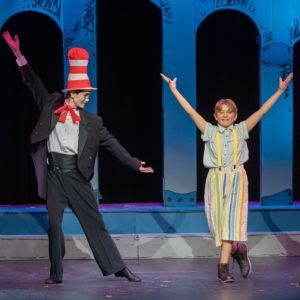 Opposite of Christensen is Joel Thomas as Horton. Thomas infuses the elephant with unfaltering optimism and compassion, making Horton the most loveable character in the production. In an otherwise crazy and convoluted story, scenes with Horton were quiet and magical. JoJo (played by Davin Smith) is very much pushed and pulled throughout the story by the Cat in the Hat, his parents, and the General, only standing on solid ground when he belts out a song and makes everyone listen. Despite a few diction issues in the rhyming script that made Smith hard to understand, his vocal performances were clear and incredibly powerful, especially in the Act I number “It’s Possible (McGelligot’s Pool).”
Opposite of Christensen is Joel Thomas as Horton. Thomas infuses the elephant with unfaltering optimism and compassion, making Horton the most loveable character in the production. In an otherwise crazy and convoluted story, scenes with Horton were quiet and magical. JoJo (played by Davin Smith) is very much pushed and pulled throughout the story by the Cat in the Hat, his parents, and the General, only standing on solid ground when he belts out a song and makes everyone listen. Despite a few diction issues in the rhyming script that made Smith hard to understand, his vocal performances were clear and incredibly powerful, especially in the Act I number “It’s Possible (McGelligot’s Pool).”
I’ve seen many different Cats in the Hat, but none as kind as this one played by Geoffrey Reynolds. Most Cats I have seen are morally neutral and live for chaos. Reynolds’s Cat still loves chaos, but only as it serves growth and imagination in young JoJo. As played by Reynolds, the Cat is funny, charming, inspirational, occasionally feisty, and adorably proud of JoJo and his journey. The few times the Cat interacted directly with the audience were especially fun. During the live auction of Horton the Elephant, the Cat comes down into the audience to find and auction random items from surprised theater goers. This interjection goes on and on, and yet I was sad to see it end, even if it did end with a snippet of “Sold” sung by John Michael Montgomery. Reynolds is quick and witty in all his ad-lib moments and has refreshing and always-funny costume changes as he goes in and out of different characters.
The costumes (designed by Tonya Christensen) are a pleasant surprise. Horton’s world is dressed in 1920’s fashion: Horton is wearing a smart gray suit with wing-tipped oxfords, and the birds are all in various types of flapper dresses. The different animal type characters are each identifiable, but through subtle costuming and makeup choices (such as the turtle dressed in newsboy-type overalls that are green with shell shapes patched here and there). The citizens of Whoville, in stark contrast to the jungle characters, are matching in yellow Edwardian/Victorian outfits. It is an odd juxtaposition, but works with the characteristics, songs, and stories of the different worlds. The most confusing costuming choice is the steampunk goggles on the Mayor of Whoville’s top hat. While the Mayor is introduced at the top of the show, there is not another glimpse of steampunk until the song when the military school students are each wearing a pair of steampunk goggles. I get it, but only after spending a quarter of the show very confused. Overall, the costuming is vibrant and equal to the task of Dr. Seuss’s fantastical characters.
It is no small feat to bring the illustrations of the classic Dr. Seuss stories to life. Alongside the costumes, the set design (from production designer Josh Scott) immediately invokes the fantastical and colorful scenes in the children’s books. However, on such a small stage, the set pieces seem too big and make the stage look cramped if more than six people were on at any given time (which happens a lot). The use of the space between the stage and the front row is brilliant, with the bottom section becoming Whoville. This solves the issue of space on stage and sets a clear visual as Horton is on stage talking to this tiny world that he is looking down to. The one trouble with this lower stage is lighting (also designed by Scott). For Who-specific scenes (especially towards the end of Act I when the Whos are being tossed and thrown about by the Wickershams), the lighting is harsh and focused, leaving half of Whoville in the dark. And during the Christmas scene, I could even see the spotlights focusing in and out.
Other than the lights on the lower stage, the only other noticeable technical flaw is volume (from sound engineer Dylan Frank). For every character outside of the main four (the Cat, JoJo, Horton, and Gertrude), it was hard or impossible to hear their vocals over the music. This is especially true and unfortunate for Mayzie LaBird, played by Barb Christensen. She is a snazzy jazzy powerhouse, but I could only hear her when she belts. Christensen’s performance is otherwise intriguing and slightly ambiguous. At times Mayzie is witty and manipulative, but there are cracks of compassion and remorse, reminding me that everyone is capable of good and bad.
I cannot fail to mention the choreography in this show. For such a small stage and such a large cast, the choreographers (Ami Gent, Venny Carranza, Mic Thompson, and Maria Vaccaro) create routine after routine of inventive and fun performances. Heavily influenced by the 1920’s jazz, the choreography is sharp and fun, letting the performers have big movements while keeping them from running into each other on the crowded stage. There are a few outliers too. Just when I got comfortable that this is strictly a jazz dance show, actress Jamie Cook’s Sour Kangaroo blasts on stage with a 1960s soul piece for “Biggest Blame Fool.” Later in the show, there is a dark and captivating tap number, complete with giant googly eyes for “Havin’ a Hunch.”
The Stage Door’s Seussical is a successful and fun summer spectacle with a big cast of “amayzing” talent. There are only a few chances left to see the show, and I highly recommend that people see it before it closes on July 16.

